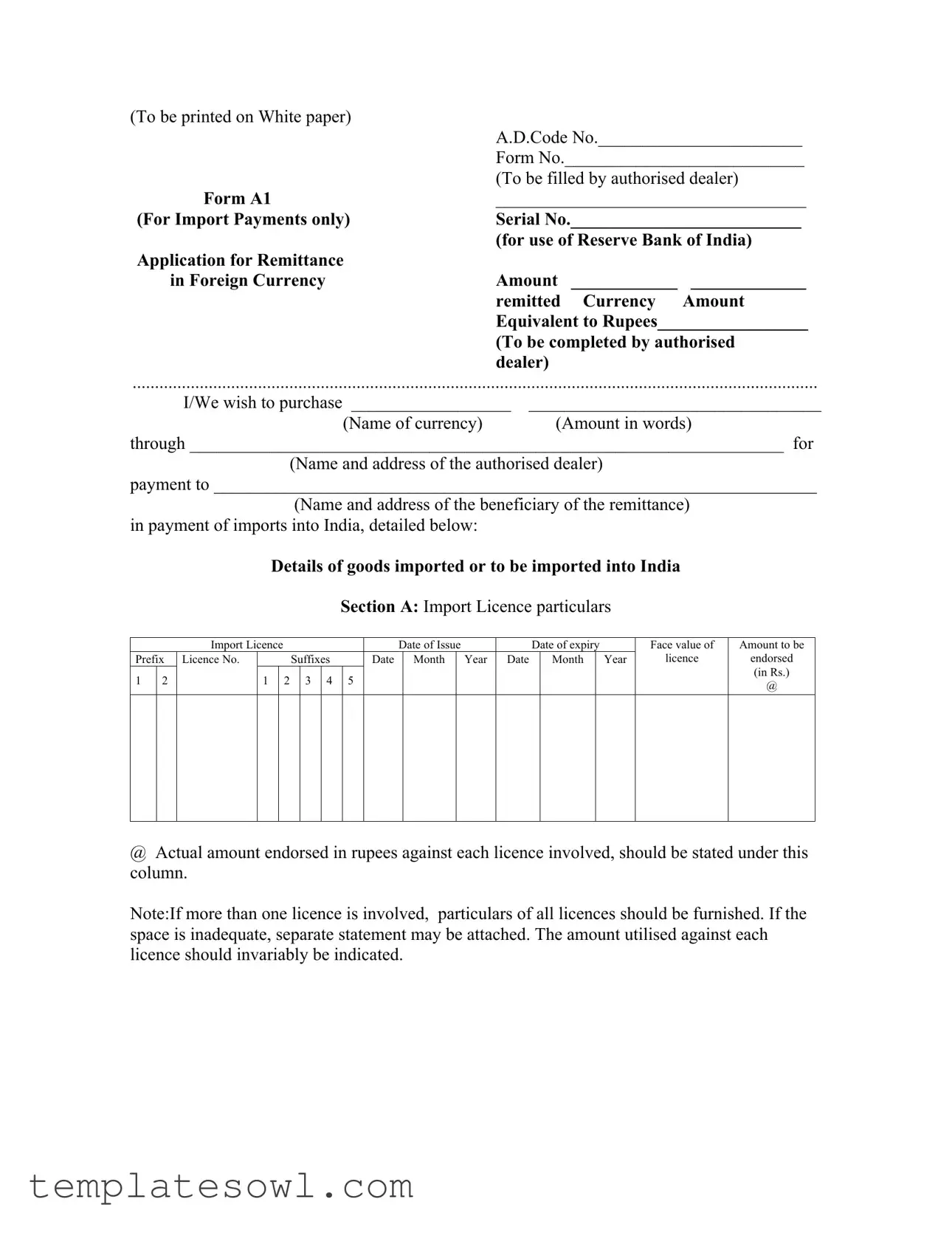
(To be printed on White paper) |
|
|
|
|
A.D.Code No._______________________ |
|
Form No.___________________________ |
|
(To be filled by authorised dealer) |
Form A1 |
___________________________________ |
(For Import Payments only) |
Serial No.__________________________ |
|
(for use of Reserve Bank of India) |
Application for Remittance |
|
|
|
in Foreign Currency |
Amount |
____________ |
_____________ |
|
remitted |
Currency |
Amount |
|
Equivalent to Rupees_________________ |
|
(To be completed by authorised |
|
dealer) |
|
|
.........................................................................................................................................................
I/We wish to purchase __________________ |
_________________________________ |
(Name of currency) |
(Amount in words) |
through ___________________________________________________________________ for
(Name and address of the authorised dealer)
payment to ____________________________________________________________________
(Name and address of the beneficiary of the remittance) in payment of imports into India, detailed below:
Details of goods imported or to be imported into India
Section A: Import Licence particulars
|
|
Import Licence |
|
|
|
|
|
|
Date of Issue |
|
|
Date of expiry |
|
Prefix |
Licence No. |
|
|
|
Suffixes |
|
Date |
|
Month |
|
Year |
Date |
|
Month |
|
Year |
1 |
2 |
|
1 |
|
2 |
|
3 |
4 |
5 |
|
|
|
|
|
|
|
|
|
|
|
|
|
|
|
|
|
|
|
|
|
|
|
|
|
|
|
|
|
|
Face value of |
Amount to be |
licence |
endorsed |
|
(in Rs.) |
|
@ |
|
|
@Actual amount endorsed in rupees against each licence involved, should be stated under this column.
Note:If more than one licence is involved, particulars of all licences should be furnished. If the space is inadequate, separate statement may be attached. The amount utilised against each licence should invariably be indicated.

Section B: Import particulars
|
Invoice Details |
|
Quantity |
Description |
Harmonised |
Country |
Country |
Mode of |
Date of |
No |
Terms |
Currency |
Amount |
of |
of goods |
System of |
of origin |
from |
shipment |
shipment |
and |
(c.i.f., |
|
|
goods |
|
Classification |
of goods |
which |
(air, sea |
(if not |
date |
f.o.b., |
|
|
|
|
|
|
goods |
post, rail |
known |
|
c.&.f. |
|
|
|
|
|
|
are |
river, |
approxi- |
|
etc.) |
|
|
|
|
|
|
consigne |
transport |
mate |
|
|
|
|
|
|
|
|
d |
port, etc.) |
date) |
|
|
|
|
|
|
|
|
|
|
|
|
|
|
|
|
|
|
|
|
|
|
|
Section C: Other particulars |
|
1. Details of forward |
|
|
|
purchase contract, |
______________ |
_______________ |
____________ |
if any, booked against |
(No.& date of |
(Currency and |
(Balance under |
the import |
Contract |
Amount of |
the contract) |
|
|
Contract) |
|
2. If remittance to be |
|
|
|
made is less than |
|
|
|
invoice value, reasons |
|
|
|
therefor (i.e. part |
_____________________________ |
|
remittance,instalment |
_____________________________ |
|
etc.)
.........................................................................................................................................................
I/We hereby declare that the statements made by me/us on this form are true and that I/we have not applied for an authorisation through any other bank.
I/We declare and also understand that the foreign exchange to be acquired by me/us pursuant to this application shall be used by me/us only for the purpose for which it is acquired and that the conditions subject to which the exchange is granted will be complied with.
Stamp
Date:....................
.......................................................................
(Signature of Applicant/Authorised Official)
@Name and Address of Applicant Importer's Code Number...........................
@Nationality .................................................
@To be filled in capital letters ................
NOTE : For remittances covering intermediary trade, form A2 should be used.
Declaration to be furnished by Applicant
I/We declare that
(a)the import licence/s against which the remittance is sought is/are valid and has/have not been cancelled by DGFT.
(b)the goods to which this application relates account*
have been* imported into India on my/our own will be *
(c)the import is on behalf of @_______________________________________* and
(d)the invoice value of the goods which is declared on this form is the real value of the
goods |
imported * |
into in India. |
|
|
to be imported* |
|
If the |
I/We attach the relative Customs-stamped Exchange Control copy of Bill of Entry * |
Import |
|
|
Post parcel wrapper (for imports by post)*/Courier Wrapper |
has been |
|
|
(for imports through courier)* |
made |
|
|
|
|
|
|
or |
If the |
|
I/We undertake |
to produce within three months to the authorised dealer the relative |
import is |
|
Customs-stamped Exchange Control copy of Bill of Entry * |
to be |
|
Post parcel wrapper (for imports by post)*/Courier wrapper |
made |
|
|
(for imports through Courier)* |
* Strike out item not applicable
@Where the import is on behalf of Central/State Government Department or a company owned by Central/State Government/Statutory Corporation, Local Body, etc. the name of the Government Department, Corporation etc. should be stated.
Date:......................................................................................
(Signature of Applicant/Authorised Official)
_____________________________________________________________________________
Space for comments of the authorised dealer
(While forwarding the application to Reserve Bank for approval, reference to Exchange Control Manual paragraph/ A.D.Circular in terms of which the reference is made should invariably be cited. If any remittance application on account of the same import was referred to Reserve Bank earlier, reference to the last correspondence/approval should also be cited).
.........................................................................
Stamp
Date:....................
(Signature of Authorised Official)
Name ...............................................................
Designation ......................................................
Name and Address of ......................................
Authorised dealer.............................................
______________________________________________________________________________
Certificate to be Furnished by Authorised Dealer (Importer's Banker)
We hereby certify that
(a)this payment is
Put a |
(i) |
• |
an advance remittance |
tick (ü) |
|
|
|
in the |
(ii) |
• in retirement of bills under Letter of Credit opened through us |
relevant |
|
|
|
block |
(iii) |
• |
against documents received through our medium for collection |
(iv)• on account of documents received direct by the applicant/s against undertaking furnished by the latter to submit Customs-stamped Exchange Control copy of Bill of Entry of Post Parcel/courier wrapper within three months
(v)• on account of documents received direct by the applicant/s against Customs-stamped Exchange Control copy of Bill of Entry/post parcel/courier wrapper (attached) submitted by the latter
(vi)• ___________________________________________________________
(any other case, to be explained)
(b)all the Exchange Control regulations applicable to the remittance have been complied with
(c)the payment to the supplier of the goods has been* made
will be*
through_____________________________________________________________
(Name & Address of the foreign bank)
We also certify/undertake that the relevant Customs-stamped Exchange Control copy of Bill of Entry or post parcel/courier wrapper
*shall be verified by us within three months
[vide certificate (a)(ii) and (iii) above].
*has been verified [vide certificate (a) (v) above].
*shall be obtained from the applicant/s within three months [vide certificate (a) (i) and (iv) above].
.......................................................................
(Signature of Authorised Official)
Name ..............................................................
Stamp
Date:....................
Designation......................................................
Name and Address of .....................................
Authorised dealer ............................................
______________________________________________________________________________
* Strike out item not applicable





